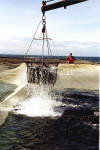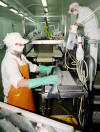 |
 |
 |
 |
 |
 |
| Salmon Farms are located in fiord like locations where
salmon pens are floated allowing circulation of cold clean water |
The average salmon will start in fresh water the be
transferred to brackish water pens where the are raised for an average
of 3 years |
Special feed high in natural oils and protein are fed
to feed to the salmon which in most instances created a higher
concentration of oils in farmed salmon versus wild. |
Great care with specialized equipment is taken not to
over feed the salmon and insure the proper diet is adhered to. |
At harvest time floating processing ships are often
used |
Nets are drawn in and buckets used to catch the salmon |
 |
 |
 |
 |
 |
 |
| The salmon are raised onto the processing ship by way
of net buckets. |
Professional processors are waiting to quickly begin
handling the fish |
Some processors use vacuum like apparatuses to pull
the salmon to the processing site though a system of pipes |
Once the salmon processing begins ice or super cooled
water is used to stun and calm the fish |
The stunned fish are quickly subdued by
cutting through the throat |
 |
 |
 |
 |
 |
 |
| Then the fish is packed for shipment to a
processing plant for further processing. |
The iced salmon then proceeds through the
factory |
Processing takes place under closely
monitored sanitation conditions o insure minimal degradation of the
fish |
Filleting can be done by hand or
mechanically but the removal of pin bones is all accomplished by hand. |
Salmon fillets are rinsed or further
processed into fillets |
Then packed for shipping |